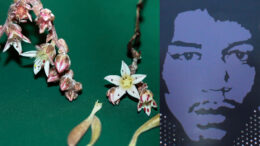 Author’s note: My “Extinction Countdown” column will mark its 20th anniversary this summer. As that milestone approaches, it’s time to look back at some previous entries and update them for the world we find ourselves in today. A shorter version of this article was published in 2017 in Scientific American, but a lot has changed since then.
Author’s note: My “Extinction Countdown” column will mark its 20th anniversary this summer. As that milestone approaches, it’s time to look back at some previous entries and update them for the world we find ourselves in today. A shorter version of this article was published in 2017 in Scientific American, but a lot has changed since then.
Will a tiny, endangered flower named after musician Jimi Hendrix fade into the purple haze of memory?
Not if the researchers who discovered it have anything to say about it. They announced the discovery of the endangered plant in hopes of mobilizing efforts to protect and conserve the remote region of Baja, Mexico where it and other rare plants are found.
The researchers — who dubbed the tiny new plant Hendrix’s liveforever or Dudleya hendrixii — said it is in desperate need of conservation.
“We estimated there were 5,000-10,000 plants on a few acres, perhaps 2-3 acres total,” botanist Stephen McCabe, one of the authors of a paper describing the new species in the journal Madroño, told me in 2017. McCabe and his co-authors said the site, part of the “botanists’ paradise” known as Colonet Mesa, faces threats from farming, livestock grazing and possible development.
Dudleya species in general are hardy plants — they don’t “live forever” as their name would imply, although they can survive uprooted without water for a year or more — but the new species’ restricted range makes it particularly vulnerable, McCabe said. The researchers warned that the site could easily be damaged or even destroyed, like castles made of sand, by an off-road vehicle or tractor.
The tiny, two-inch flower itself doesn’t immediately bring Jimi Hendrix to mind, but it’s not all about appearances. It turns out that the researcher who first encountered the plant at Colonet Mesa, Mark Dodero of RECON Environmental, was listening to Hendrix’s song “Voodoo Child” when he made the discovery.
That experience led McCabe, who saw Hendrix perform at the Santa Clara County Folk Rock Festival in 1969, to suggest the name, something he hoped would bring this rare flower — and maybe other plants along with it — some much-needed attention. “Jimi Hendrix was one of a number of musicians concerned about what people were doing to the environment,” he said. “This was at least a small part in embracing the choice of the name. I also liked the common name we could give, Hendrix’s liveforever, because when a poet, writer, painter or musician shares something that inspires people, I hope those inspirational creations or insights can live on after the artist passes.”
McCabe admitted the naming angle was PR-worthy, but said it was an important aspect of attracting notice for this rare plant. “Cute animals easily get publicity, but it’s trickier for plants,” he told me. “We have to be clever to get attention about plants. Getting people to even register that they exist is the first step in getting people to appreciate the liveforevers and some of our other rare plant species.”
In this case, it worked: The plant’s discovery made headlines around the world. Heck, it even has its own Wikipedia page.
But publicity only lasts so long. Now that the initial attention has died down, the question remains: Will Dudleya hendrixii continue to exist as long as its namesake’s memory? As with any endangered species, there “ain’t no telling” what the future brings, but McCabe told me in 2017 he hoped that the plant will persist, and so far it has.
Let Me Grow Next to Your Fire
Flash forward to 2024, and McCabe himself has persisted in identifying new plants. He’s helped describe three more Dudleya species in the past two years, the most recent in Orange County, California. That discovery, announced in March, confirms a species that another researcher first observed in the 1950s without collecting scientific specimens.
It wasn’t an easy rediscovery. The species grows on cliffs, and McCabe and his colleagues needed permission from a private landowner to access the site. They “bushwhacked their way through dense foliage and poison oak to find the plant’s steep habitat,” according to a report from the American Public Gardens Association. “We got permission from this landowner to come up from the bottom, and there had been a fire there,” said McCabe. “The vegetation had recovered from the fire and included Ceanothus, which has really sharp thorns on it, so it was really unpleasant.”
They named this one Dudleya chasmophyta, or the crevice-loving Dudleya, a shift in taxonomic strategy that reflects the times. “There’s a movement to not name things after people but to try and name them after some feature of the plant, and in this case ‘crevice-loving’ seemed like a good moniker.”
And if that moniker helps spread some love or appreciation for rare flowers with unique characteristics, that’s all the better.
Previously in The Revelator:
You Can’t Save a Species If It Doesn’t Have a Name


